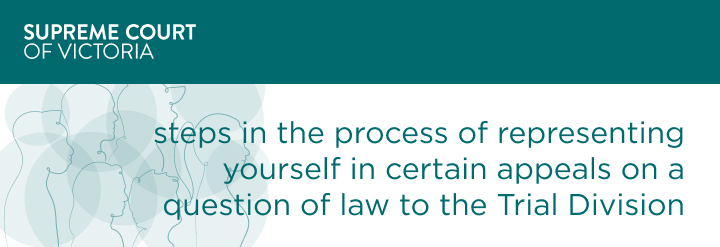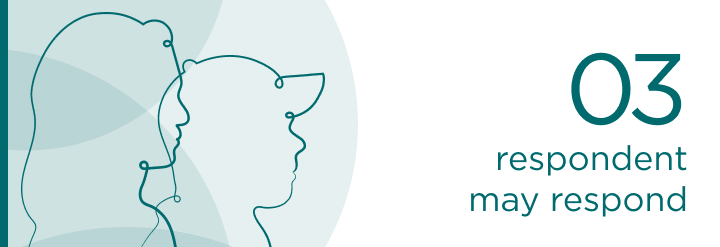A guide on when you appeal a decision made by the Magistrates' Court, in the Trial Division of the Supreme Court of Victoria.

The Trial Division of the Supreme Court is where you appeal a decision made by the Magistrates’ Court. This applies for both civil and criminal decisions.
We have separate printed guides available for both, but the process is largely the same for appealing a decision by the Magistrates' Court in a civil matter as it is for a criminal matter.
Guide - Appeal a decision made by the Magistrates' Court

The information in the guide is for court users. It includes what to do at each step, what forms you need to complete, what documents you need to provide, court fees and costs that apply in the Supreme Court.
Our one-page overview summarises the steps in the process of representing yourself in an appeal on a question of law from a Magistrates’ Court civil decision.
You can also download the printable guides at the bottom of the page.
There are two types of Magistrates’ Court criminal appeals that can be heard by the Supreme Court:
- Appeals on a question of law
- Appeals where there is a conviction and sentence imposed by the Chief Magistrate.
There is a different process for appeals against a conviction and sentence, which is not covered here. See section 110A of the Magistrates’ Court Act 1989. Contact the Self-represented Litigant Coordinator to discuss your situation.
This information is for Magistrates’ Court criminal appeals on a question of law. If the decision was made by the Chief Magistrate the appeal is to be made to the Court of Appeal.
Appeals on a question of law
Appeals on a question of law are when you believe the magistrate made a legal error in the way they applied the law. For example, if you believe the magistrate:
- failed to take into account a relevant factor, or
- took into account an irrelevant factor, or
- misinterpreted a legislative provision, or
- misinterpreted the function of the court.
You cannot appeal on a question of law for any other reason. For example, your appeal may not be allowed if your argument is that you are unhappy with the decision or if you want to show the Court new material that was not part of the case heard in the Magistrates’ Court.
An appeal does not automatically ‘stay’ (temporarily halt) a decision, where an order has been made by the Magistrates’ Court. The Supreme Court may make a stay order after considering the facts of your case.
You can only appeal on a question of law where a final order of the Magistrates’ Court has been made.
Effect on your right to appeal to the County Court
If you appeal to the Supreme Court on a question of law, you permanently give up the right to appeal to the County Court of Victoria in relation to the proceeding.
This right cannot be reinstated.
See section 272 of the Criminal Procedure Act 2009.
Where is the appeal heard?
The Supreme Court of Victoria has two main parts: Trial Division and Court of Appeal. Trial Division hears appeals against a Magistrates’ Court criminal decision on a question of law unless the decision was made by the Chief Magistrate.
Time limits
You have 28 days, from the date the decision was made, to file a Notice of Appeal form. The date of the decision is on the Magistrates’ Court order. See Step 1 for details on how to file this form.
Extension of time to appeal
If 28 days have passed, you must apply for the Court’s permission to appeal outside the time limit. This is called ‘seeking leave to appeal out of time’. You do this in Step 1 when you file your Notice of Appeal.
Attach to the Notice of Appeal an affidavit that briefly explains why you are applying late and any special circumstances — for example, if you were ill or injured.
Attach to the affidavit as an ‘exhibit’ any documents that support your request, such as a medical certificate. This affidavit (and supporting exhibits) can be the same one you file as part of ‘additional documents’ in Step 1. The affidavit you file at this step is not when you make legal arguments about your case. Its purpose is only to show the judge why they should give you an extension of time to appeal.
What is an appeal?
An appeal is not a new trial or re-hearing of your case. It must be based on 'a question of law'. This means you can only appeal a decision if you believe the magistrate made a legal error in the way they applied the law.
You cannot appeal for any other reason. For example, your appeal may not be allowed if your argument is that you are unhappy with the decision or if you want to show the Court new material that was not part of the case heard in the Magistrates' Court. See Section 109 of the Magistrates Court Act 1989.
If you are appealing a decision made in a criminal matter, refer to Section 272 of the Criminal Procedure Act 2009. Contact the Self-represented Litigant Coordinator to discuss your situation.
The Supreme Court of Victoria has two main parts: Trial Division and Court of Appeal. Trial Division hears appeals against a Magistrates' Court civil decision. If the decision was made by the Chief Magistrate the appeal is to be made to the Court of Appeal.
Time limits
There is a time limit on appealing a Magistrates' Court civil decision. You have 30 days, from the date the decision was made, to file a Notice of Appeal form. The date of the decision is on the Magistrates' Court order. See Step 1 for details on how to file this form.
Extension of time to appeal
If 30 days have passed, you must apply for the Court's permission to appeal outside the time limit. This is called 'seeking leave to appeal out of time'. You do this in the documents you file in Step 1 of the appeal process.
In the Notice of Appeal, briefly explain why you are seeking leave to appeal out of time. In the affidavit, briefly explain why you are applying late and any special circumstances you want the Court to consider - for example, if you were ill or injured.
Attach to the affidavit as an 'exhibit' any documents that support your request to appeal out of time, such as a medical certificate. Complete a cover sheet for each exhibit. See the Appendix for a link to a template cover sheet called Certificate Identifying Exhibit (Form 43A).
Consider the cost
Before you apply, consider if you have tried all ways to resolve the issue without involving the justice system.
Legal proceedings in the Supreme Court can be very expensive.
If you lose your case, you may need to pay some or all of the other party’s costs. This includes what they spent on lawyers and any other expenses, such as the cost of expert reports.
Be aware – these costs can be substantial.
Consider paying for some legal advice even if it is only to help you with a particular part of the process. For example, it is highly recommended that a lawyer help you prepare your grounds of appeal and submissions. These are two key things you need to argue your case. See organisations that may be able to help you.
There are no court fees if you are appealing a criminal decision made in the Magistrates’ Court.
Get to know Magistrates' Court civil procedures
Read the following documents carefully. They provide important information and guidance:
- Steps in the process of representing oneself in an appeal on a question of law from a Magistrates’ Court civil decision
- Magistrates Court Act 1989 – section 109
- Supreme Court (General Civil Procedure) Rules 2015 – Order 58.06 – 58.14, Order 6 (service)
- Civil Procedure Act 2010 – sections 16-26, and sections 41-42
- Practice Note SC CL 9 – Judicial Review and Appeals List
- Practice Note SC Gen 7 – Transcript in Civil Proceeding.
If you contact the Court, quote the proceeding number for your case. You are given this number when your documents are accepted by the Court in Step 1. It looks something like this S ECI 2019 54321.
Get to know Magistrates' Court criminal procedures
Read the following documents carefully. They provide important information and guidance:
- steps in the process of representing oneself in an appeal on a question of law from a Magistrates’ Court criminal decision
- Criminal Procedure Act 2009 – section 272
- Supreme Court (Criminal Procedure) Rules 2017 – order 3A
- Practice Note SC CL 9 – Judicial Review and Appeals List.
If you contact the Court, quote the proceeding number for your case. You are given this number when your documents are accepted by the Court in Step 1. It looks something like this S ECI 2019 54321.
Do your legal research
Make sure you understand the law that applies to your case by doing some legal research. Read about cases similar to yours. Note any cases where the law you are relying on has been applied in a way you think proves your arguments. You may want to refer to these cases in your submissions. You might also include these cases in your List of authorities, which the Court may ask you to prepare in Step 5. You can find cases from all courts on the AustLII website.
Create a RedCrest account
You file documents with the Court using the online system RedCrest.
The RedCrest Electronic Filing User Guide has information and instructions.
Before you file documents, the Court encourages self represented litigants to contact the Self-represented Litigant Coordinator. The Coordinator can talk to you about Court process and check you have the right documents. They cannot give legal advice.
For instructions on how to set up a RedCrest account, visit our Videos page.
Get to know legal terms
Check the glossary for common legal words and terms.
Know how to stop an appeal
You can stop an appeal if you have the consent of all parties or permission from the Court.
Be aware that if you stop your appeal, you usually need to pay the respondent’s costs up to that point unless:
- you and the respondent agree you do not have to pay their costs, or
- the Court orders that you do not have to pay their costs.
To stop your appeal, complete a Notice of Discontinuance form stating that you are stopping your appeal and sign it.
Ask the respondent to sign too, to show they agree. Then file the form in RedCrest and wait for a RedCrest notification that a copy with the Court’s seal is available. Download the sealed copy and serve it on the respondent.
If the respondent will not sign the form, you need to get the Court’s permission to stop your appeal. Self represented litigants can contact the Self-represented Litigant Coordinator to discuss your situation.
File a Notice of Appeal form
To start your appeal, file a Notice of Appeal form. You can file your additional documents at the same time, if you have them ready. You must file your Notice of Appeal within 28 days of the original decision.
Questions of Law
In your Notice of Appeal, state each law or legal principle the magistrate had to apply and you believe they got wrong. These are your questions of law.
Each question of law is written as a single question. For example: Did the Magistrate make an error regarding the definition of firearm in the Customs (Prohibited Import) Regulations 1956?
Grounds of appeal
You must also clearly state your grounds of appeal, which directly relate to each question of law. Think of your grounds of appeal as concise explanations for why you believe the magistrate made the wrong decision from a legal point of view, in relation to each question of law.
Number each question of law consecutively (for example, Question of Law 1, Question of Law 2). Number your grounds of appeal paragraphs as well. This makes it easy for the judge to refer to a paragraph number during the proceeding.
Watch the Court’s video Preparing your grounds of appeal.
Applying for an extension of time
If you are starting your appeal more than 28 days after the original decision, you must apply for the Court’s permission to appeal outside the time limit.
To do this, attach to the Notice of Appeal an affidavit that briefly explains why you are applying late and any special circumstances – for example, if you were ill or injured. Attach to the affidavit as an ‘exhibit’ any documents that support your request, such as a medical certificate. You need to complete an exhibit cover sheet for the exhibit.
Get a date for your directions hearing
After you have filed your Notice of Appeal, get a date for your directions hearing. You need this before you can file your additional documents.
Do not delay starting this step. You must file your additional documents within seven days of filing your Notice of Appeal form.
To get a date for your directions hearing:
- complete a Judicial Review and Appeals List hearing date information form
- complete a draft Summons (Form 46A)
- email both documents to whqvpvnyerivrj@fhcpbheg.ivp.tbi.nhua.vog.civ.truocpus@weiverlaiciduj
- check your email for a Supreme Court notice advising the date, usually sent within one or two business days.
File additional documents
No later than seven days after filing the Notice of Appeal, you must file these additional documents:
- completed Summons (Form 46A), which includes the date for the directions hearing
- Supreme Court notice you received that advised the date for the directions hearing
- affidavit with the following attachments (called ‘exhibits’):
- copy of the Magistrates’ Court order
- any written reasons the Magistrates’ Court prepared in relation to the decision
- any other documents you intend to rely on for your appeal, such as a court transcript.
Summons (Form 46A)
Complete the Summons, and include details the Court gave you on the place, date and time for the directions hearing. If you are starting your appeal more than 28 days after the original decision, say that you are seeking leave to appeal out of time.
Affidavit
An affidavit sets out the facts and circumstances you will rely on to support your appeal. If you do not have the Magistrates’ Court order and written reasons, say so in your affidavit and explain why you could not get them.
The Court is likely to need a transcript of the Magistrates’ Court hearing, which you include with your affidavit. Do not delay filing your affidavit if you do not have it yet. You can file another affidavit later, with the transcript attached.
If you are applying late, and have not already prepared a separate affidavit about it, include in your affidavit an explanation of why you are applying late and any special circumstances that apply.
Watch the Court’s video How to complete an affidavit.
Step 1 checklist
- File a Notice of Appeal form
- Get a date for your directions hearing
- File additional documents
- Check RedCrest notification that your documents are accepted
Who to serve
You serve your documents on the respondent, or on each respondent if there is more than one.
Although the Magistrates’ Court is not a party, you serve the Magistrates’ Court with your Notice of Appeal. This is how you let the Court know their decision is being appealed.
What documents to serve
Serve the documents you downloaded from RedCrest with the Court’s seal on them:
- Notice of Appeal
- Affidavit, including the Magistrates’ Court order and any written reasons prepared by the Magistrates’ Court
- Summons (Form 46A).
When to serve documents
Serve these documents as soon as possible after you were notified in RedCrest that your documents were accepted. Do this at least 14 days before the directions hearing.
How to serve documents
If you are serving an individual, you must serve the Notice of Appeal in person. This means you must:
- leave a copy of the document with the person to be served, or
- if the person does not accept the copy, put it down near them and tell them the nature of the document.
If you are serving a company, you can post your documents to the registered office of the company. The Court may request you to swear or affirm an affidavit stating that you have served your documents.
You are allowed to serve the additional documents by email or post. However, if your additional documents (summons, affidavit and exhibits) are ready you can serve them at the same time as the Notice of Appeal.
TIP: Although some documents need to be served in person, you do not need to do this yourself. You can ask a friend, family member or a professional to serve the documents for you. They must be prepared to sign an affidavit confirming they served the documents, if the Court requests this.
Step 2 checklist
- Download from RedCrest and print your documents with the Court’s seal on them
- Serve your documents on the respondent
 Once you have served your documents on the respondent, they may do nothing or they may respond in a number of ways. For example, the respondent may:
Once you have served your documents on the respondent, they may do nothing or they may respond in a number of ways. For example, the respondent may:
- File a Notice of Appearance and serve it on you. A Notice of Appearance is how a respondent officially lets you and the Court know that they want to be involved in the proceeding. It means they are likely to attend the directions hearing.
- Make an application to the Court of their own. There are many different types of applications the respondent can make. You can read about them in the Supreme Court (General Civil Procedure) Rules 2015 and the relevant law.
- File an affidavit opposing your application. The respondent must serve on you any documents they file with the Court.
Step 3 checklist
- The respondent may serve documents on you in response to your documents

A directions hearing is a short hearing to decide matters related to the timing of when things happen during the proceeding. This includes what has to happen, who does it and when it needs to be done.
If a directions hearing is scheduled, the Court expects the appellant and respondent to attend. If you cannot attend for any substantial reason, for example if you have a medical emergency, contact the Court immediately.
At the directions hearing, you usually find out the date for the final hearing of your appeal. You may be asked to estimate how many days you think the final hearing will take.
The directions hearing is not when you present your arguments to the Court. This happens at the final hearing.
What to bring to the directions hearing
Bring the documents you filed in Step 1, something to make notes on such as a notepad, tablet or laptop and your diary (so you can check if dates proposed are suitable).
After the directions hearing
After the directions hearing, the Court will send you a formal copy of the Court’s orders. The orders say what you and the other parties need to do to prepare for the final hearing.
Step 4 Checklist
- Attend the directions hearing
Follow the Court’s instructions
The orders made at the directions hearing will tell you what you have to do to get your case ready for the judge.
Watch the Court’s video: Preparing for a hearing.
Some things you may need to prepare include:
List of authorities
This lists the cases, legislation and other resources such as textbooks and journal articles you say support your case.
These are things you will refer to in your submissions – the arguments you want the judge to consider.
Outline of submissions
An outline of submissions draws together your facts of the case, what happened in the Magistrates’ Court case, the law that applies (legislation and cases) and your explanation of why you believe the magistrate made any legal errors. These should be arranged under headings that correspond to the questions of law and grounds of appeal, which you prepared in Step 1. You can expand on some or all of these points at the hearing.
Affidavit
In addition to the affidavit you filed in Step 1, this contains any additional evidence you want the Court to consider, which was not in your original affidavit.
Electronic Court book
This is an electronic book containing digital copies of all the documents that you and the respondent intend to rely on during the hearing. For example, it might contain witness statements, expert reports, invoices or other material relevant to your case. Each digital document is numbered, and listed in the index at the front of the e-court book. The Court will order who is responsible for filing the e-court book.
Your response to the respondent’s outline of submissions
You have the opportunity to respond to the respondent’s outline of submissions, if they prepared these and served them on you in Step 3.
Prepare to present at your hearing
Prepare yourself for the hearing by watching the video on our website: Attending Court – the day of your hearing.
Step 5 Checklist
- Follow the Court’s instructions about what to do
- Prepare for the hearing by watching the Court’s videos
Finding out your hearing date
The date for the final hearing is usually decided at the directions hearing. The hearing date is usually 6-9 months after the directions hearing, except in urgent cases. This gives all parties enough time to properly prepare their case.
The Court will send you an order that confirms the date.
What to expect at the hearing
To help understand what to expect at the final hearing, including what to bring with you, how to address the judge, where to sit and what you will need to do, watch the video: Attending Court – the day of your hearing.
A final hearing of an appeal case usually takes between half a day and one full day, depending on the complexity of the case. The hearing does not usually involve the calling of witnesses. It focuses on the documents both parties have filed.
Step 6 Checklist
- Expect an order confirming the date for your final hearing
- Watch the video: Attending Court – the day of your hearing
- Attend the final hearing
When to expect the decision
The judge usually ‘reserves’ their decision (judgment). This means they do not give a judgment on the day of the hearing but at a later date. This gives the judge time to consider both parties’ submissions and write reasons for their decision.
You can expect a decision within weeks or months of the final hearing, depending on the complexity of the case.
Finding out the decision
The Court will email you a date and time when you need to return to Court to get the judge’s decision. This is called the ‘handing down’ of the decision. Appellants and respondents are expected to attend. However, if you do not attend the Court will email you the decision automatically.
At the handing down of the decision, if you lose the appeal the respondent will usually ask the Court to order you to pay their costs. If you win, you can ask the Court to order the respondent to pay your costs, if you had any.
If your appeal is successful
If your appeal is successful, the Court may make one or more of the following orders (under section 272 of the Criminal Procedure Act 2009):
- an order requiring the proceeding to be heard and decided again by the Magistrates’ Court, either with or without the hearing of further evidence
- any other order the Court thinks appropriate.
If your appeal is not successful
If your appeal is not successful (dismissed), you can seek leave to appeal this decision to the Court of Appeal.
Step 7 Checklist
- Expect an email from the Court advising when to come to the Court to get the decision
- Attend the decision ‘hand down’
- Know your options if your appeal is not successful
Self represented litigants who require further guidance can contact the Self-Represented Litigant Coordinator.






